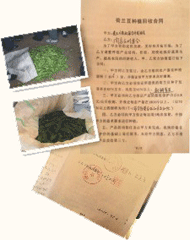The first Step : Schools Leading Local Economic Development
Every village boasts at least one middle school featuring several highly-educated teachers busy fostering the next generation of talents. Schools are the most likely to first adopt outside knowledge and use the newest technology to create wealth. By giving schools access to computer systems, these computers take on an e-learning role. In addition, Town and Talent Technologies will provide training, Internet management, and of course, endless encouragement. By doing so, schools will be able to quickly use computers and the Internet to foster 21rst century SET skills: Software, English and Typing. This will also greatly increase the number of students continuing their educations.
School teachers will guide their students in gathering information needed to create websites. This information includes: local customs, businesses, specialties, culture and others. These websites will then be posted online, providing a window to life in remote rural western China. Teachers and students already possessing basic SET skills can communicate with people in the outside world. This will only hasten the arrival of outside knowledge. By disseminating knowledge of the Internet and computers, the economic benefits of the two become readily apparent to villagers. This will in itself stimulate greater interest and usage of computers and the Internet. It lays a solid foundation for the future of Internet-based economies.
The Second Step :Maximizing E-Business
Areas boasting specialty agricultural and pastoral products are the most likely to engage in e-business. E-businesses in these locations consist of listing local specialty goods online, thus entering and facing the challenges of the world's largest marketplace. This maximizes the potential for profit. Stimulating local e-business is one of the chief goals of schools leading local economic development. This will allow local agricultural and pastoral producers to discover up-to-date market news and prices as soon as possible. While the fledgling e-business already conducted in this underdeveloped area is certainly inspiring, its scale is still too minor. These products were largely sold by a rare few farmers, a mere fraction of the total potential transactions that could have taken place if an e-business platform were employed.
 In today's market of supply exceeding demand, agricultural producers must have their own e-business marketplace. Agricultural products must be sold according to the same model as the OEM system. We must use scientific methods and the keen management skills of e-business to better coordinate the sale of agricultural goods. As with the OEM system, we must produce according to set demand. Once a buyer specifies his demands and provides the needed material, equipment, and technique, the supplier can assemble the good. At this point, the buyer is committed to purchasing the finished product. Local government can supervise and assist with the growing e-business transactions in underdeveloped areas. Schools and Digital Centers with the Internet access can act as e-business centers, drawing upon computer resources and the Internet to advertise local products and specialties online. As e-business holds no geographical limits, numerous agricultural villages can band together to form a larger-scale unit. This would instill heightened competitiveness in the global market, allowing them to enter into larger-scale transactions. E-business offers the exceptional opportunity to produce according to buyer demands. In today's market of supply exceeding demand, agricultural producers must have their own e-business marketplace. Agricultural products must be sold according to the same model as the OEM system. We must use scientific methods and the keen management skills of e-business to better coordinate the sale of agricultural goods. As with the OEM system, we must produce according to set demand. Once a buyer specifies his demands and provides the needed material, equipment, and technique, the supplier can assemble the good. At this point, the buyer is committed to purchasing the finished product. Local government can supervise and assist with the growing e-business transactions in underdeveloped areas. Schools and Digital Centers with the Internet access can act as e-business centers, drawing upon computer resources and the Internet to advertise local products and specialties online. As e-business holds no geographical limits, numerous agricultural villages can band together to form a larger-scale unit. This would instill heightened competitiveness in the global market, allowing them to enter into larger-scale transactions. E-business offers the exceptional opportunity to produce according to buyer demands.
The Third Step : Improving the Agricultural & Pastoral Economy
Rural villages can use the Internet to learn of the latest planting techniques and highest-quality seeds. They can research which products are currently in demand in the marketplace, permitting them to adapt the nature of the agricultural and pastoral economy. This would ultimately result in greater profits. This system not only allows local producers to create wealth at home, but also improves the overall quality and depth of their experience. Buyers will have ever-increasing demands regarding quantity and quality of goods, and sellers will no doubt adopt an Internet framework to better manage their production and improve their competitiveness.
Once OEM evolves to a certain point, the profit margins of buyers and sellers become linked. For this reason, buyers have a growing incentive to transfer even more techniques and knowledge to sellers. The sellers would also become more willing to adjust their production and quality to suit buyer needs. In this way, OEM would encourage simultaneous economic development to the benefit of both buyer and seller. At this time, it would? launch an era of improved ODM (Original Design Manufacturing), the next step beyond OIM (Original Idea Manufacturing).
Innovative products emerging from the development of a mutually beneficial buyer-seller relationship, local specialty goods, organic foods, and improved packaging would all work to increase overall sales. This could only result in increased profits. The ultimate end would be to permanently transform the nature of the agricultural and pastoral economy.
|